To decorate a small garden plot, you have to show a lot of imagination. Limited funds and space do not allow to equip a pond, a terrace with a waterfall, and so on. One of the interesting landscape design options is a dry stream with your own hands.
The concept of "dry stream" and its benefits
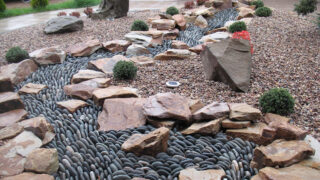
For a real reservoir or stream, it is necessary to establish water exchange. This is not always possible. At the same time, such landscape elements adorn the site very much. Dry stream is an original alternative to water flow. It is a decorative channel, marked by a scattering of stones, flowering plants on the "banks" and decorative elements: figurines, jugs, lamps and even bridges. The channel has very whimsical bends, since its purpose is to highlight a certain area.
The advantages of this option:
- a decorative stream does not require the installation of a water supply and drainage system;
- the organization takes a minimum of time and requires much less effort;
- there is no need to use electrical equipment such as pumps, compressors;
- a waterless channel does not need to be carefully looked after;
- the route does not depend on the features of the relief;
- the channel can appear and disappear in any convenient place;
- this is a great way to mark areas on a site.
The only drawback is the lack of running water. The ornamental stream is less soothing.
Design features and types
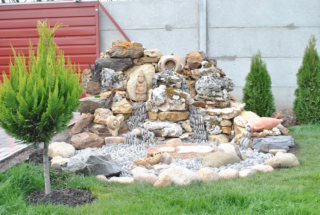
The channel is purely aesthetic in nature, but when organizing it, certain rules must be observed, otherwise the dry reservoir will not last long.
- Since the element imitates a trickle, you need to dig a depression for it.
- The bottom is waterproofed - this is a prerequisite. Otherwise, flood or rainwater will erode the stone channel.
- A "flow" is made by filling the depression with stones.
- Plants are placed along the contours of the banks. This is important: if grass and flowers grow directly along the riverbed, the element loses its appearance as a stream.
A dry river is often combined with mini-ponds.
There is no official classification for a dry stream at your dacha. The models are divided according to the nature of the channel.
- Winding - 1 channel, changing direction and size. It can be made wider or narrower, forming stone reservoirs.
- Branched - includes several channels that spread over different areas and can converge or end in dry or real ponds.
- Cascading - an option for a site with sharp elevation changes or slopes. A stone current of small pebbles from the hill "falls" onto the terraces and rifts of a mountain stream formed from large flat stones.
Waterfalls often start with an overturned jug. And dry ponds are decorated with sculptures of fish, frogs, mermaids.
DIY instructions for creating a dry stream
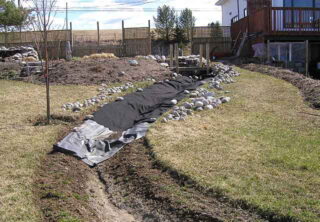
The construction technology is quite simple. More time is spent on site assessment and project development. Such an element of the landscape should be performed in the style of a garden, and its shape, length and decor depend on it.
- Installation begins with a layout. It is better to use a sketch of your own site for this. The stream is intended to visually deepen the space and make it larger.
- Mark the selected area with sand.It is better to place the source on a hill.
- Determine the dimensions. The best ratio of depth to width is 1: 2. If the channel width is 1.5 m, then its depth should be 0.75 m.
- Dig a trench. The top fertile layer is removed and used on the site. The walls of the trench are kept at an angle of 45 degrees.
- Weed roots are removed, the bottom is tamped.
- Lay in a trench waterproofing - a film or roofing felt.
- The channel is covered with a layer of crushed stone and expanded clay with a diameter of up to 5 cm. Then it is sprinkled with sand.
- On the resulting pillow, stones of various shapes and sizes are laid out, which form a decorative stream. You do not need to fasten them.
- Plants are planted along the banks.
The stone current retains moisture, therefore, moisture-loving flowers grow beautifully on its banks.
Decorating methods
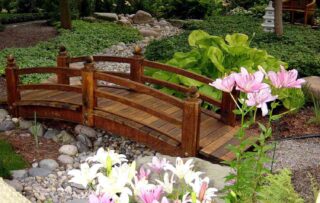
Do-it-yourself stream decor is created by combining stones of different shapes. Often, such a channel does not need additional decorations.
The techniques are as follows:
- large stones are chosen for the source and an embankment is built that imitates a rock;
- large stones of an unusual shape are installed at turns and thresholds;
- shallow water creates a scattering of finely rounded pebbles;
- the effect of thresholds or cascade is created by alternating areas with small pebbles and larger flat ones, imitating terraces;
- dark stones indicate deep areas, and light ones - shallow water.
You can supplement the landscape with a bridge or materials at hand: lay a log or a long stone.
Stones and plants
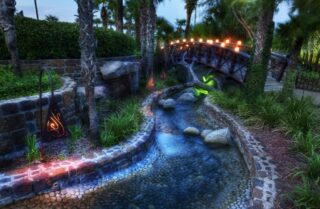
For a dry pond or stream in the country, it is better to take stones with a smooth surface and rounded shapes. In the middle latitudes, large cobblestones, small gray-blue pebbles are used in the garden. Basalt, gneiss, and especially shale will do. The latter is famous for its variety of textures and colors.
You can also find painted stones. Sometimes even fluorescent paints are used: such a channel glows in the dark with a bluish color.
Plants are selected depending on the landscape. But usually preference is given to such plants that adorn the shores of real reservoirs.
- Blooming - it is recommended to plant varieties with blue, blue, purple buds in order to give the elements a resemblance to water. Plants with white and silver flowers also look great.
- Carpet stuns - evergreen bryozoan, creeping tenacious, cotoneaster, barberry. They create a beautiful bright backdrop and make cleaning easier.
- Cereals and reeds - miscanthus, sedge, calamus, host create the illusion of thickets and freshness.
- Conifers are a great idea for a long, voluminous stream with ponds and shallow waters. Dwarf species of pines, junipers, and spruces are used. They grow well on sandy or loamy soil, do not clog the rock bed and give the landscape a nobleness.
In "French" gardens, plants are chosen from the opposite. Here, the correct shape of the channel is emphasized by a lush flower bed.
Maintaining the attractive appearance of a dry stream

Stone stream maintenance is simple.
- Periodically, the bushes and flowers around the riverbed are trimmed with garden shears. They should not grow long enough to obscure the view of the riverbed.
- The stones at the bottom have to be periodically sorted out and destroyed the anthills arranged under them.
- Large boulders on the banks are decorated with moss. But the bottom of it needs to be cleaned.
- Plants on the shore need to be looked after: loosen the soil, fertilize, water in hot weather.
It is recommended to clean the rock bottom from fallen leaves and grass. For the winter, the stream itself is not covered, and some plants need protection.
Arrangement of a dry stream does not present any difficulties. However, it can serve not only as a design element, but also serve as a drainage system for the removal of storm and flood waters. In this case, it is recommended to additionally strengthen the bottom by applying glue or cement mortar to the point. It is advisable to make the channel relatively straight and place it under some slope.








